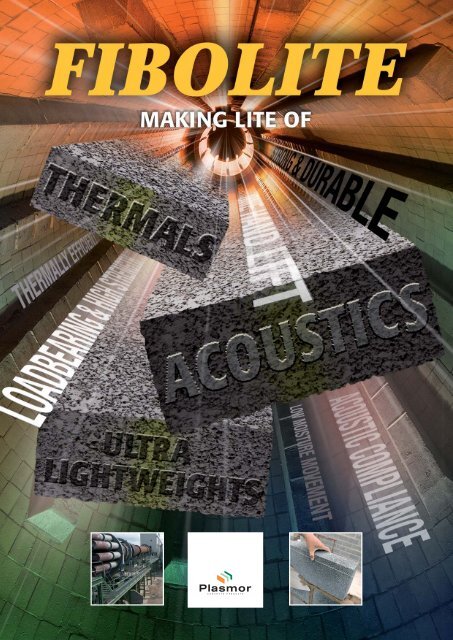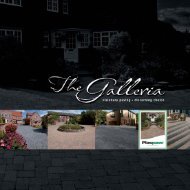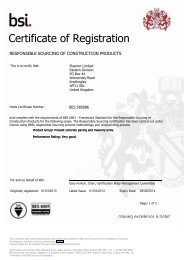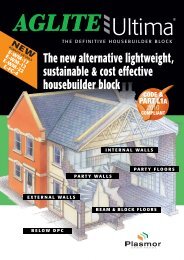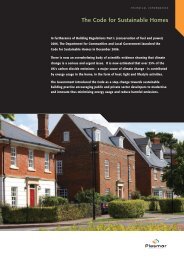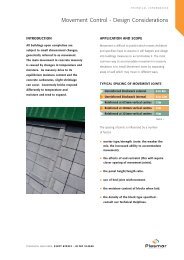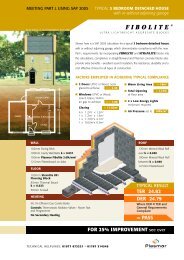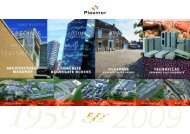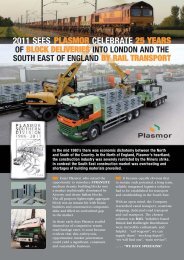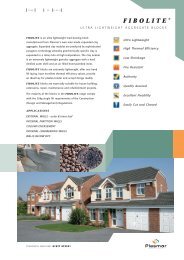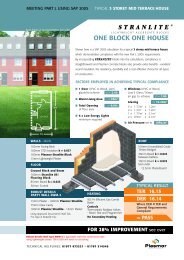fibolite - Plasmor
fibolite - Plasmor
fibolite - Plasmor
Create successful ePaper yourself
Turn your PDF publications into a flip-book with our unique Google optimized e-Paper software.
FIBOLITE - making lite of Part E regulations<br />
Recent amendments to Robust Details Part E (Resistance to the<br />
Passage of Sound) now permits the use of <strong>Plasmor</strong> Fibolite blocks<br />
in flanking walls in conjunction with <strong>Plasmor</strong> Stranlite blocks<br />
in the separating (party) wall. The amendments apply to both<br />
E-WM-2 and E-WM-4 wall types.<br />
This revised regulation recognises the acoustic properties of<br />
Fibolite blocks in flanking wall applications and together with<br />
Fibolite's thermal performance, low moisture movement properties<br />
and its ultra lightweight, emphasises Fibolite as the building block<br />
of choice for the discerning specifier and builder.<br />
EXTERNAL (FLANKING) WALL USING PLASMOR FIBOLITE BLOCKS E-WM-2<br />
TOOTHED<br />
SEPARATING<br />
WALL<br />
TIED<br />
SEPARATING<br />
WALL<br />
PLAN<br />
Masonry outer leaf<br />
External wall cavity (minimum 50mm)<br />
Close cavity with a flexible cavity stop unless it is fully filled with<br />
built-in insulation<br />
Separating walls 100mm <strong>Plasmor</strong> Stranlite<br />
Inner leaf where there is no separating floor e.g. for houses<br />
• 100mm <strong>Plasmor</strong> Fibolite (850 to 950 kg/m 3 )<br />
• Internal finish -13mm plaster or nominal 8kg/m 2<br />
gypsum based board<br />
SEPARATING WALL USING PLASMOR STRANLITE BLOCKS E-WM-2<br />
■ <strong>Plasmor</strong> Stranlite blocks<br />
■ Wet plaster<br />
Block density 1375 to 1400 kg/m 3<br />
Wall ties Approved Document E ‘Tie Type A’<br />
Clear cavity width 75mm (min)<br />
Block thickness<br />
100mm (min), each leaf<br />
Wall finish 13mm plaster or cement: sand render with plaster skim (min 10 kg/m 2 ),<br />
both sides<br />
External (flanking) wall Masonry (both leaves) with 50mm (min) cavity - clear, fully filled<br />
or partially filled with insulation<br />
NOTE: Where there is a separating floor eg. flats/apartments, the party floor is subject to pre-completion acoustic testing.<br />
GOOD SITE PRACTICE<br />
Keep cavity and wall ties free from mortar dropping and debris<br />
Fully fill all blockwork joints with mortar<br />
•<br />
Make sure there is no connection between the two leaves except for wall ties and foundations<br />
Keep any chases for services to a minimum and fill well with mortar<br />
EXTERNAL (FLANKING) WALL USING PLASMOR FIBOLITE BLOCKS E-WM-4<br />
SEPARATING<br />
WALL<br />
TOOTHED<br />
SEPARATING<br />
WALL<br />
TIED<br />
PLAN<br />
Masonry outer leaf<br />
External wall cavity (minimum 50mm)<br />
Close cavity with a flexible cavity stop unless it is fully filled with<br />
built-in insulation<br />
Separating walls 100mm <strong>Plasmor</strong> Stranlite<br />
Inner leaf where there is no separating floor e.g. for houses<br />
• 100mm <strong>Plasmor</strong> Fibolite (850 to 950 kg/m 3 )<br />
• Internal finish -13mm plaster or nominal 8kg/m 2<br />
gypsum based board<br />
SEPARATING WALL USING PLASMOR STRANLITE BLOCKS E-WM-4<br />
■ <strong>Plasmor</strong> Stranlite blocks<br />
■ Wet plaster<br />
Block density 1375 to 1400 kg/m 3<br />
Wall ties Approved Document E ‘Tie Type A’<br />
Clear cavity width 75mm (min)<br />
Block thickness<br />
100mm (min), each leaf<br />
Wall finish<br />
Gypsum based board (nominal 8kg/m 2 ) mounted on dabs on<br />
cement:sand render (nominal 8mm) with scratch finish.<br />
Typical render mix 1:1:6 to 1:1/2:4. Render mix must not be<br />
stronger than background<br />
External (flanking) wall Masonry (both leaves) with 50mm (min) cavity - clear, fully<br />
filled or partially filled with insulation<br />
NOTE: Where there is a separating floor eg. flats/apartments, the party floor is subject to pre-completion acoustic testing.<br />
GOOD SITE PRACTICE<br />
• As above, plus. Ensure that render is applied to the complete face of each leaf with a scratch finish<br />
(it may be omitted within the floor joist/beam zone)
A SUSTAINABLE AND ECOLOGICAL FUTURE<br />
HISTORIC PERSPECTIVE<br />
For three decades during the 1960’s, 70’s and 80’s<br />
the staple raw material for quality lightweight aggregate<br />
block manufacture was Coal Fired Power Station Furnace<br />
Bottom Ash. During this period many coal fired power<br />
stations were contributing base load electricity supply<br />
to the National Electricity Grid and were being supplied<br />
by a myriad of UK collieries. Furnace bottom ash is the<br />
residue of burning coal and provides a strong, light,<br />
totally inert block making aggregate.<br />
THE CHANGING ENERGY MARKET<br />
During the late 1980’s and early 90’s the UK Energy<br />
market witnessed significant and dramatic changes.<br />
Due to political, economic and environmental pressures<br />
a high proportion of UK collieries and coal fired power<br />
stations were irreversibly closed down. This presented<br />
an acute dilemma to the lightweight aggregate block<br />
industry; how to secure future long-term supplies of<br />
quality lightweight aggregate. The choices facing the<br />
industry were numerous; consider expensive and<br />
unreliable imported aggregate, move to heavier quarried<br />
virgin aggregates, source sub-standard secondary<br />
aggregates or simply rely on the residual supply of power<br />
station furnace bottom ash. Considering the “Dash for<br />
Gas”, the conversion of some coal fired power stations<br />
to oil burning and the increasing pressures of the<br />
Environmental Movements, these were not options<br />
of merit for <strong>Plasmor</strong>.<br />
FOCUS ON EXPANDED CLAY<br />
In 1990 the <strong>Plasmor</strong> Board of Directors committed the<br />
company to an extensive and exhaustive research and<br />
development project with the expressed intention of<br />
developing a totally new, reliable, long term supply of<br />
premium quality sustainable block making aggregate.<br />
Over a number of years the Company trialed a great<br />
many raw materials and processes including reclaimed<br />
and recycled materials all to little avail.<br />
The future was undoubtedly found in Expanded Clay.<br />
After years of geological and chemical research,<br />
laboratory testing and incremental pilot testing the<br />
Company decided to pursue expanded clay, and<br />
pioneered the expanded clay process in the UK.<br />
Expanded clay nodules are produced by sophisticated<br />
pyrogenic technology whereby geochemically specific<br />
clay is expanded in a rotary kiln at high temperature.<br />
The first <strong>Plasmor</strong> expanded clay kiln was commissioned<br />
in 2000 and represented the biggest single investment<br />
in the Company’s history.<br />
<strong>Plasmor</strong> view expanded clay as the key to the<br />
sustainable and ecological future of concrete block<br />
manufacture as it absolves the need for expensive<br />
imports and lowers the use of virgin, hard, quarried<br />
aggregates such as limestone, granite, sand and<br />
gravel. Use of expanded clay in lightweight aggregate<br />
blocks offers customers a number of important<br />
benefits:-<br />
Lighter blocks giving faster laying rates and CDM<br />
20kg compliance<br />
Thermal and Acoustic Building Regulation approval<br />
Consistent High Quality means less wastage on site<br />
due to breakages<br />
Lower moisture movement (0.40mm/m) giving<br />
greater structural performance<br />
Consistent block structure giving excellent fixability<br />
Totally inert material giving greater fire resistance<br />
Class 1 aggregate as defined in BS 5628 -3<br />
Guaranteed consistent supply of quality block<br />
making aggregate
FIBOLITE - making lite of Part L regulations<br />
U-values achieved using FIBOLITE blocks<br />
BLOCKWORK<br />
100mm FIBOLITE<br />
INSULATION<br />
100mm Rockwool<br />
INTERNAL FINISH<br />
Plasterboard on dabs<br />
U-Value = 0.28W/m 2 K<br />
BLOCKWORK<br />
100mm FIBOLITE<br />
INSULATION<br />
100mm Dritherm<br />
Cavity Slab 32<br />
INTERNAL FINISH<br />
Plasterboard on dabs<br />
U-Value = 0.25W/m 2 K<br />
BLOCKWORK<br />
100mm FIBOLITE<br />
INSULATION<br />
100mm Polypearl Plus<br />
INTERNAL FINISH<br />
Plasterboard on dabs<br />
U-Value = 0.28W/m 2 K<br />
BLOCKWORK<br />
100mm FIBOLITE<br />
INSULATION<br />
100mm Ecobead<br />
Platinum<br />
INTERNAL FINISH<br />
Plasterboard on dabs<br />
U-Value = 0.26W/m 2 K<br />
BLOCKWORK<br />
100mm FIBOLITE<br />
INSULATION<br />
85mm Dritherm<br />
Cavity Slab 32<br />
INTERNAL FINISH<br />
50mm Gyproc<br />
Thermaline Basic<br />
U-Value = 0.22W/m 2 K<br />
BLOCKWORK<br />
100mm FIBOLITE<br />
INSULATION<br />
50mm Kingspan TW50<br />
INTERNAL FINISH<br />
Plasterboard on dabs<br />
U-Value = 0.27W/m 2 K<br />
The illustrations shown here are just a few examples of wall constructions that achieve 0.30 W/m 2 K or better.<br />
For further information or calculations contact our Technical Department: 01977 673221 ■ 01767 314545<br />
FULL FILL CAVITY<br />
Green figures = achieves 0.30 W/m 2 K or better<br />
Brick outer leaf<br />
300mm (max) wall width<br />
Rockwool<br />
Cavity Wall Batts<br />
Dritherm<br />
Cavity Slab<br />
Isowool CWS<br />
Dritherm<br />
Cavity Slab 32<br />
Isowool Hi-Cav 32<br />
k - value 0.037 0.037 0.036 0.032 0.033<br />
Finish 80mm 90mm 100mm 85mm 100mm 85mm 100mm 75mm 85mm 100mm 75mm 85mm 100mm<br />
100mm Fibolite Lightweight Plaster 0.35 0.32 0.29 0.33 0.29 0.32 0.28 0.32 0.29 0.26 0.33 0.30 0.27<br />
Plasterboard on dabs 0.33 0.31 0.28 0.32 0.28 0.31 0.28 0.31 0.29 0.25 0.32 0.29 0.26<br />
FULL FILL CAVITY - blown or injected insulants<br />
Brick outer leaf<br />
300mm (max) wall width<br />
Polypearl Plus<br />
Instafibre/<br />
Energysaver<br />
Ecobead Platinum<br />
k - value 0.037 0.039 0.033<br />
Finish 85mm 100mm 75mm 85mm 100mm 75mm 85mm 100mm<br />
100mm Fibolite Lightweight Plaster 0.33 0.29 - 0.34 0.30 0.33 0.30 0.27<br />
Plasterboard on dabs 0.32 0.28 0.35 0.33 0.29 0.32 0.29 0.26<br />
FULL FILL CAVITY - Insulated Plasterboards<br />
Brick outer leaf<br />
300mm (max) wall width<br />
Dritherm<br />
Cavity Slab 32<br />
k - value 0.032<br />
Finish 75mm 85mm 100mm<br />
100mm Fibolite 50mm Gyproc Thermaline Super 0.20 0.19 0.18<br />
50mm Gyproc Thermaline Basic 0.24 0.22 0.20<br />
SAP ENERGY RATING SERVICE<br />
<strong>Plasmor</strong> technical sales offices have fully trained<br />
support staff using government approved computer<br />
software, who can work with you to produce SAP<br />
rating certificates for your projects. Charges apply<br />
PARTIAL CAVITY FILL<br />
Brick outer leaf - 50mm (min) clear cavity<br />
300mm (max) wall width<br />
Kingspan TW50<br />
Celotex tuff-R<br />
CW3000Z<br />
Xtratherm XT/CW<br />
k - value 0.023 0.023 0.023<br />
Finish 40mm 45mm 50mm 40mm 45mm 50mm 40mm 45mm 50mm<br />
100mm Fibolite Lightweight Plaster 0.32 0.30 0.28 0.32 0.30 0.28 0.32 0.30 0.28<br />
Plasterboard on dabs 0.31 0.29 0.27 0.31 0.29 0.27 0.31 0.29 0.27
FIBOLITE<br />
FEATURES/BENEFITS<br />
ONE HAND LIFT<br />
ULTRA LIGHTWEIGHT – IMPROVES LAYING RATES<br />
ULTRA LIGHTWEIGHT<br />
SATISFIES CDM REGULATIONS<br />
THERMALLY EFFICIENT<br />
SIMPLE SOLUTIONS TO ‘U’ VALUES DOWN TO<br />
U = 0.25W/m 2 K<br />
ACOUSTIC COMPLIANCE<br />
PART ‘E’ ROBUST DETAIL FOR FLANKING WALLS<br />
STRONG AND DURABLE<br />
LOWER WASTAGE THAN ALTERNATIVE<br />
ULTRA LIGHTWEIGHTS<br />
LOADBEARING AND HIGH STRENGTH<br />
3.6N/mm 2 , 7.3N/mm 2<br />
LOW MOISTURE MOVEMENT<br />
0.40MM/M – LOWER SHRINKAGE<br />
FIXABILITY<br />
DIRECT NAILING, EASY AND SPEEDY TO DRILL<br />
AND PLUG<br />
EASILY CUT AND CHASED<br />
SAVES TIME AND EFFORT<br />
AUTHORITY<br />
MANUFACTURED TO BS EN 771-3<br />
QUALITY MANAGEMENT STANDARD<br />
BS EN ISO 9001<br />
BEWARE OF IMITATIONS!
“The future is secure<br />
and we’re all fired up<br />
about expanded clay”<br />
EXPANDED CLAY GIVES MARKET BOOST TO FIBOLITE<br />
The upsurge in demand for ultra lightweight<br />
“aggregate” blocks which satisfy CDM<br />
regulations, meet builders needs for thermal<br />
performance down to 0.25w/m 2 K and comply<br />
with Part E Acoustic regulations in flanking<br />
walls, has led to unprecedented demand for<br />
<strong>Plasmor</strong> FIBOLITE blocks.<br />
Such has been the success of the first expanded<br />
clay kiln and the demand for FIBOLITE that<br />
<strong>Plasmor</strong> have recently, in 2007, successfully<br />
commissioned a second kiln to meet demand.<br />
<strong>Plasmor</strong> now operate the only two expanded<br />
clay kilns in the UK, both the most hi-tech,<br />
sophisticated, fuel efficient and environmentally<br />
clean plants in Europe.<br />
Concurrent with the expansion of expanded clay<br />
production, the Company have acquired secure,<br />
long term sources of the very specific clay<br />
required for the process.<br />
TECHNICAL HELPLINES:<br />
01977 673221 ■ 01767 314545


